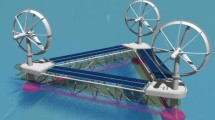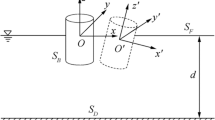Abstract
To simulate the dynamic responses of the multibody system with a floating base when the upper parts spread with a certain sequence and relative speed, the homogeneous matrix method is employed to model and simulate a four-body system with a floating base and the motions are analyzed when the upper parts are spread sequentially or synchronously. The rolling, swaying and heaving temporal variations are obtained when the multibody system is under the conditions of the static water along with the wave loads and the mean wind loads or the single pulse wind loads, respectively. The moment variations of each joint under the single pulse wind load are also gained. The numerical results showed that the swaying of the floating base is almost not influenced by the spreading time or form when the upper parts spread sequentially or synchronously, while the rolling and the heaving mainly depend on the spreading time and forms. The swaying and heaving motions are influenced significantly by the mean wind loads. The single pulse wind load also has influences on the dynamic responses. The torque of joint 3 and joint 4 in the single pulse wind environment may be twice that in the windless environment when the system spreads with 60 s duration.
Similar content being viewed by others
References
Cha JH, Roh MI, Lee KY (2010). Dynamic response simulation of a heavy cargo suspended by a floating crane based on multibody system dynamics. Ocean Engineering, 37(14-15), 1273–1291. DOI: 10.1016/j.oceaneng.2010.06.008
de Wilde J, Serraris JJ, de Ridder EJ, Becel ML, Fournier JR (2010). Model test investigation of LNG tandem offloading with dynamic positioned shuttle tankers. ASME, Shanghai, 453–460. DOI: 978-0-7918-4909-5
Denavit J, Hartenberg RS (1955). A kinematics notation for lower-pair mechanisms based on matrices. Trans. ASME J. Appl. Mech., 22, 215–221.
Dostal L, Kreuzer E (2013). Surf-riding threshold of ships in random seas. Proceedings in Applied Mathematics and Mechanics, 13(1), 383–384. DOI: 10.1002/pamm.201310187
Du NJ, Shen YG, Zhang JH (2014). The dynamic response analysis of the multi-body system with Floating base based on the ADAMS. Applied Mechanics and Materials, 574, 58–61. DOI: 10.4028/www.scientific.net/AMM.574.58
Ellermann K, Kreuzer E (2003). Nonlinear dynamics in the motion of floating cranes. Multibody System Dynamics, 9(4), 377–387. DOI: 10.1023/a:1023361314261
Ellermann K, Kreuzer E, Markiewicz M (2002). Nonlinear dynamics of floating cranes. Nonlinear Dynamics, 27(2), 107–183. DOI: 10.1023/a:1014256405213
Hu C, Kashiwagi M (2008). A CFD approach for extremely nonlinear wave-body interactions: development and validation. IUTAM Symposium on Fluid-Structure Interaction in Ocean Engineering, Hamburg, 8, 129–140. DOI: 10.1007/978-1-4020-8630-4_12
Jang JH, Kwon SH, Jeung ET (2012). Pendulation reduction on ship-mounted container crane via T-S fuzzy model. Journal of Central South University of Technology, 19(1), 163–167. DOI: 10.1007/s11771-012-0986-5
Jiang Z, Shen Q, Chen X, Zhao H (2010). Study on the application of the homogeneous matrix method of the multi-body system to the dynamic response of floating bridge. Chinese Journal of Computational Mechanics, 27(6), 1036–1041. (in Chinese)
Kim BW, Sung HG, Kim JH, Hong SY (2013). Comparison of linear spring and nonlinear FEM methods in dynamic coupled analysis of floating structure and mooring system. Journal of Fluids and Structures, 42, 205–227. DOI: 10.1016/j.jfluidstructs.2013.07.002
Kim JH, Kim Y (2014). Numerical analysis on springing and whipping using fully-coupled FSI models. Ocean Engineering, 91(15), 28–50. DOI: 10.1016/j.oceaneng.2014.08.001
Kral R, Kreuzer E (1999). Multibody systems and fluid-structure interactions with application to floating structures. Multibody System Dynamics, 3(1), 65–83. DOI: 10.1023/a:1009710901886
Kreuzer E, Pick MA, Rapp C, Theis J (2014). Unscented Kalman filter for real-time load swing estimation of container cranes using rope forces. Journal of Dynamic Systems Measurement and Control–Transactions of the ASME, 136(4), 121–130. DOI: 10.1115/1.4026602
Kreuzer E, Wilke U (2002). Mooring systems–A multibody dynamic approach. Multibody System Dynamics, 8(3), 279–297. DOI: 10.1023/a:1020917529011
Lee I, Choi H (2015). A discrete-forcing immersed boundary method for the fluid-structure interaction of an elastic slender body. Journal of Computational Physics, 280(1), 529–546. DOI:10.1016/j.jcp.2014.09.028
Legnani G, Casolo F, Righettini P, Zappa B (1996a). A homogeneous matrix approach to 3D kinematics and dynamics. Part 2: applications. Mechanisms and Machine Theory, 31(5), 589–605.
Legnani G, Casolo F, Zappa B, Righettini P (1996b). A homogeneous matrix approach to 3D kinematics and dynamics Part 1: theory. Mechanisms and Machine Theory, 31(5), 573–587.
Li H, Shun P, Ren H, Wang Y(2013). Dynamic coupling analysis of mooring systems for a spar platform in time-varying wind. Journal of Huazhong University of Science and Technology (Natural Science Edition), 41(2), 36–40. (in Chinese) DOI: 10.13245/j.hust.2013.02.020
Rui XT, Kreuzer E, Rong B, He B (2012). Discrete time transfer matrix method for dynamics of multibody system with flexible beams moving in space. Acta Mechanica Sinica (English Series) 28(2), 490–504. DOI: 10.1007/s10409-012-0025-7
Shen Q, Li Y, Chen X J (2003). Dynamic analysis of multibodies system with a floating-base for rolling of ro-ro ship caused by wave and slip of heavy load. Journal of Marine Science and Application, 2(2): 17–24. DOI: 10.1007/BF02918659
Surendran S, Lee SK, Reddy JVR, Lee G (2005). Non-linear roll dynamics of a ro-ro ship in waves. Ocean Engineering, 32(14-15), 1818–1828. DOI: 10.1016/j.oceaneng.2004.11.014
Wang Q, Sun LP, Ma S (2010). Time-domain analysis of FPSO-tanker responses in tandem offloading operation. Journal of Marine Science and Application, 9(2), 200–207. DOI: 10.1007/s11804-010-9070-4
Woodburn P, Gallagher P, Ferrant P, Borleteau JP (2003). EXPRO-CFD: Development and validation of CFD based co-simulation of spar/CALM buoy fluid structure interaction. In: Chung JS, Wardenier J, Frederking RMW, Koterayama W. eds. Proceedings of the Thirteenth International Offshore and Polar Engineering Conference, Honolulu, USA, 175–181.
Xia D, Ertekin RC, Kim JW (2008). Fluid-structure interaction between a two-dimensional mat-type VLFS and solitary waves by the Green-Naghdi theory. Journal of Fluids and Structures, 24(4), 527–540. DOI: 10.1016/j.jfluidstructs.2007.10.009
Yuan B, Ying HQ, Xu JW (2007). Simulation of turbulent wind velocity based on linear filter method and MATLAB Program Realization. Structural Engneers, 23(4), 55–61. DOI: 10.15935/j.cnki.jggcs.2007.04004
Zhang J, Zhang K, Zhou A, Zhou T, Hu D, Ren J (2014). Analysis of nonlinear dynamic response of wind turbine blade under fluid-structure interaction and turbulence effect. Journal of Engineering for Gas Turbines and Power–Transactions of the ASME, 136(10): 26–30. DOI: 10.1115/1.4027965
Zhang RY, Chen CH, Tang YG (2012). Study on the dynamic characteristic for spar type floating foundation of offshore wind turbine. Applied Mechanics and Materials, 170–173, 2316-2321. DOI: 10.4028/www.scientific.net/AMM.170-173.2316
Zhang YL, Shen Q, Chen XJ (2006). Synchronous effect of slipping heavy loads on ro-ro ship rolling in waves. Applied Mathematics and Mechanics (English Edition), 27(7), 959–966. DOI: 10.1007/s10483-006-0712-y
Zhao W, Yang J, Hu Z, Xie B (2013). Hydrodynamics of an FLNG system in tandem offloading operation. Ocean Engineering, 57(1), 150–162. DOI: 10.1016/j.oceaneng.2012.09.015
Zhao WH, Yang JM, Hu ZQ, Tao LB (2014). Prediction of hydrodynamic performance of an FLNG system in side-by-side offloading operation. Journal of Fluids and Structures, 46, 89–110. DOI: 10.1016/j.jfluidstructs.2013.11.021
Author information
Authors and Affiliations
Corresponding author
Additional information
Foundation item: Supported by the National Natural Science Foundation of China (Grant No. 51009147) and Major State Basic Research Development Program of China (973 Program) (Grant Nos. 2014CB046801 and 2014CB046804).
Rights and permissions
About this article
Cite this article
Jiang, Z., Shao, L. & Shao, F. Numerical simulation of the spreading dynamic responses of the multibody system with a floating base. J. Marine. Sci. Appl. 14, 290–301 (2015). https://doi.org/10.1007/s11804-015-1302-1
Received:
Accepted:
Published:
Issue Date:
DOI: https://doi.org/10.1007/s11804-015-1302-1




